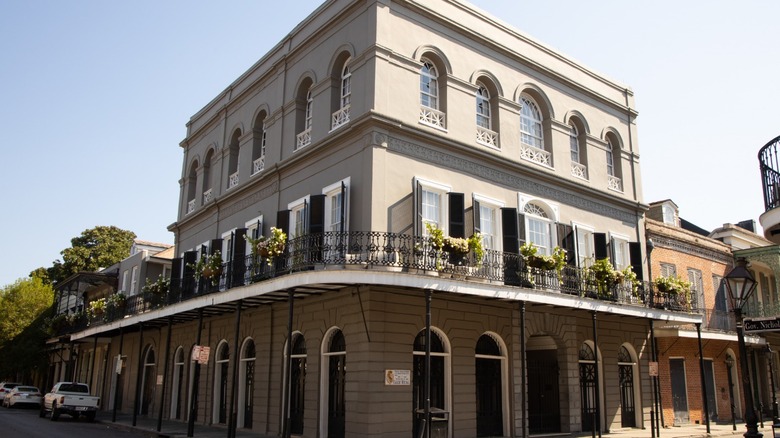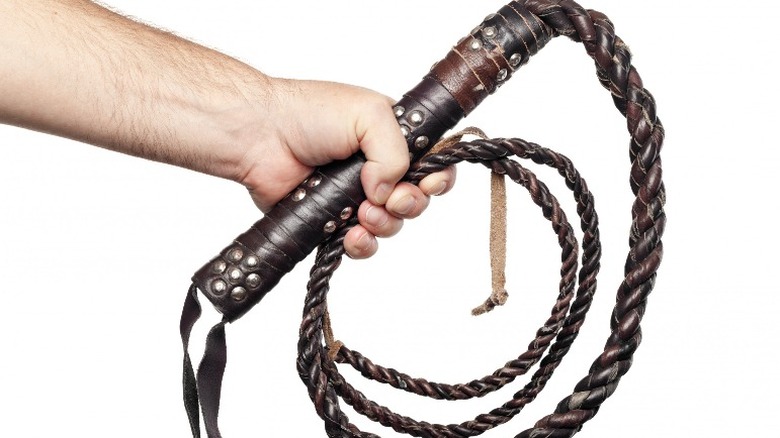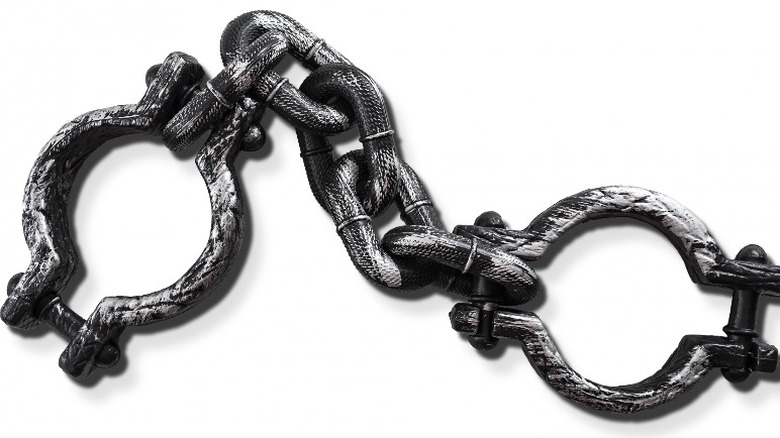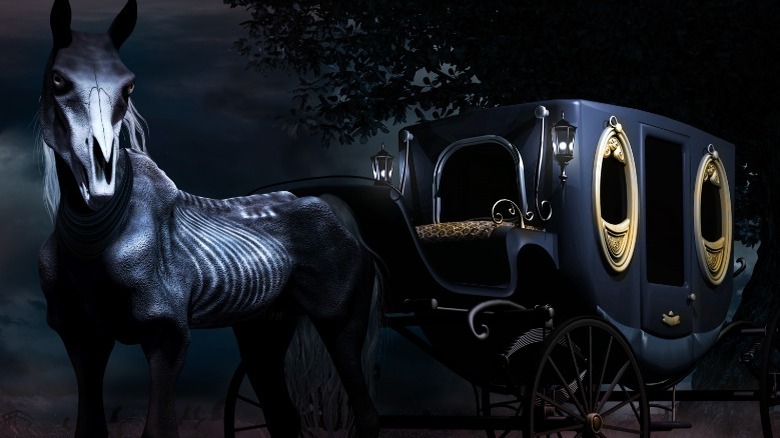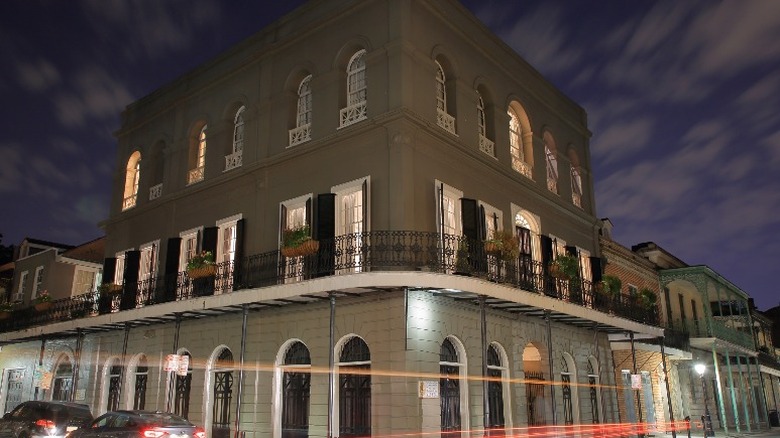The Disturbing Atrocities Authorities Discovered In The LaLaurie Mansion
The port city of New Orleans is steeped in a history that is equally enchanting as it is haunted. The melting pot of Indigenous Americans, victims of the African slave trade, and settlers/enslaved people from various spots in the Caribbean were settled in a region that was colonized first by the French (per Britannica). Later, in the hands of the Spanish government in the mid-18th century, the area we now call the state of Louisianna made its way back to the French before being sold to the United States by Napoleon Bonaparte via the Louisianna Purchase in 1803. With three different empires controlling the city, its reputation for diversity was cemented in the history books.
Those who crave tales of horror don't have to look too hard in the city. New Orleans is a popular destination for ghost hunters and thrill seekers, perhaps outdrawing the tourists who travel there to learn about the city's rich history. One such tale that has captivated the imagination of many visitors involves a wealthy physician and his sadist wife who preyed on the enslaved people they kept in bondage.
Dr. Leonard Louis and Delphine LaLaurie moved into their mansion on Royal Street in 1831, bringing with them two of her daughters from a previous marriage and an undetermined number of enslaved people (via All That's Interesting). The picturesque exterior that was the marvel of the neighborhood covered up levels of cruelty the city had not experienced before or ever since. After an incident in 1834, the public got to see firsthand the sadistic torment its many occupants were forced to endure.
A track record for cruelty
To those who knew her, Delphine LaLaurie had a sinister side to her as well as a fiery temper. It was certainly no secret that the woman was a cruel mistress to the humans she and her husband kept in bondage. The family enslaved several people who were put to work tending to the house and to the immediate needs of those who lived in it. Considered a symbol of upper status at the time, the keeping of persons in perpetual servitude was wicked enough without the crack of a whip. And LaLaurie took no issue being on the giving end of any instrument that inflicted pain.
"Retrospect of Western Travel" recalls a time in 1833 when one of the young enslaved people was tending to the lady of the house. As she was brushing Delphine LaLaurie's hair, the young girl accidentally pulled a tangle too forcefully. In response, LaLaurie grabbed a whip and began striking the poor girl with it. Not much is known of the enslaved girl that was enduring the beating, other than that she was named Lia and was only 8 years old. Lia fled from her attacker, only to have LaLaurie pursue her on a chase throughout the mansion. Lia ran from floor to floor, up into the attic, and out the window onto the roof. A neighbor could hear the screams and watched the carnage unfold on the street below.
Lia either fell from the roof or jumped to escape the whip. Her body was gathered by LaLaurie and buried in the backyard.
A fire exposed her crimes
Today, Delphine LaLaurie would have been tried for murder. But in those days, you got a slap on the wrist for such an offense against a person you enslaved. Authorities did take some action against the sadistic LaLaurie, however. According to "Retrospect of Western Travel," the household was stripped of its nine remaining enslaved people after being found guilty of cruelty. But being forced to forfeit her enslaved didn't faze LaLaurie. She arranged for close friends to buy them during the forced sale and quietly bought them all back from them. It's speculated that she only had them delivered to her so that she could inflict more suffering on the poor souls.
The level of pain these people were forced to endure wasn't known until the following year after the mansion went up in flames (via History). While LaLaurie was frantically trying to save her expensive belongings, rescuers descended on the home. In the kitchen, they found a 70-year-old enslaved woman chained to a cookstove. She revealed to them that she had intentionally started the fire so that she could be free from the harsh treatment at the hands of LaLaurie.
As these brave citizens would quickly discover, the cook wasn't the only person being brutalized by LaLaurie. The woman led them to a locked door, the horrors behind it kept secret from the high society members that were often wined and dined by LaLaurie. The door was broken down, and the extent of LaLaurie's sadism was at last exposed to the world.
The horrors are revealed
There were nine enslaved people kept behind lock and key at one time, but rescuers only found seven of them alive on the other side of the door (via "Retrospect of Western Travel"). They were severely emaciated, the victims of starvation. It's reported that bones protruded from their skin and that their advanced stages of hunger had left them looking inhuman. LaLaurie had chained each of them, some in prone positions that added to the agony. One was found chained to the floor on all fours, while another was secured with his arms stretched upward to the ceiling. Several were fitted with spiked collars, forcing them to keep their heads in an upright position.
On the wall was one of her whips, caked with blood and stiff from it drying on the leather. It was later determined that her daily routine involved finishing her breakfast, then making her way to this hidden torture chamber and whipping its inhabitants until she grew too tired to continue. The stepladder she used was found among her implements of torture, allowing her to stand higher so that she could inflict more pain with each crack of her whip.
The weak and broken victims were taken from the room and given refuge. Two died within a day of their rescue. The remains of two others were found buried in the yard. Word of the living nightmare that had unfolded in front of the neighbors spread as quickly as the fire they had assembled to extinguish. A large crowd gathered in front of the mansion.
LaLaurie and her husband make a quick escape
The fire was quickly put out, and the mansion kept presumably livable, so Delphine LaLaurie shut herself back inside and went about her business. But she knew that her days were numbered. For guidance, she consulted her coachman. He was one enslaved person who was treated well by LaLaurie, and he remained very loyal to her. He advised her to pack everything that she could and leave the mansion after dinner (via "Retrospect of Western Travel").
That evening, LaLaurie and her husband appeared in their coach in front of the growing mob. Seeing that they were about to flee their wrath, the mob began to attack the vehicle. Using his whip, the coachman kept the angry crowd at bay enough for him to lead the couple to a hasty retreat. He is said to have taken them to the docks, where the captain of a schooner was bribed to accept them as passengers on his journey to Mobile, Alabama.
What happened to the coachman afterward is not clear. But it was said that the mob eventually caught up to the escape vehicle and destroyed it, even going so far as to kill the horses that carried it. Where LaLaurie wound up is up for speculation, but the most accepted account is that she eventually made her way back to France. Some say she lived there under an assumed name, dying there in 1842 (per History).
The LaLaurie Mansion today
The LaLaurie Mansion still stands today, having been gutted and rehabilitated several times since the fire in 1834. All That's Interesting reports that the building was used for many different purposes over the years, including a music conservatory, an integrated school, and a homeless shelter. It was also renovated and retrofitted for apartments.
The mansion has changed hands plenty over the years and has at least one familiar name on the deed. Actor Nicolas Cage purchased the home in 2007. He told Vanity Fair that he planned to live in the home while he penned a horror novel, though the book, if written at all, was never released.
Visitors to New Orleans can see the mansion today, fully restored and positioned as one of the gems of the French Quarter — from the outside. The building's current owners use it as a private residence and will not allow the public inside. Though tour groups are legally permitted to stop in front of the home for their guides to deliver the chilling details of the mansion's sordid history, hopes of seeing the interior will most likely have to wait until it changes hands again.
